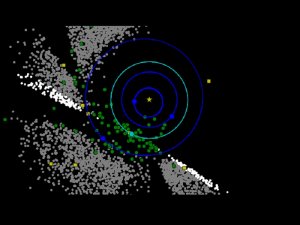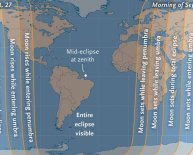
Galaxies Closest to Earth
 "The NEOWISE analysis shows us we've made a good start at finding those objects that truly represent an impact hazard to Earth, " said Lindley Johnson, program executive for the Near-Earth Object Observation Program at NASA Headquarters in Washington. "But we've many more to find, and it will take a concerted effort during the next couple of decades to find all of them that could do serious damage or be a mission destination in the future."
"The NEOWISE analysis shows us we've made a good start at finding those objects that truly represent an impact hazard to Earth, " said Lindley Johnson, program executive for the Near-Earth Object Observation Program at NASA Headquarters in Washington. "But we've many more to find, and it will take a concerted effort during the next couple of decades to find all of them that could do serious damage or be a mission destination in the future."
The analysis also suggests that about twice as many PHAs as previously thought are likely to reside in "lower-inclination" orbits, which are more aligned with the plane of Earth's orbit. In addition, these lower-inclination objects appear to be somewhat brighter and smaller than theother near-Earth asteroids that spend more time far away from Earth. A possible explanation isthat many of the PHAs may have originated from a collision between two asteroids in the mainbelt lying between Mars and Jupiter. A larger body with a low-inclination orbit may have broken up in the main belt, causing some of the fragments to drift into orbits closer to Earth andeventually become PHAs.
Since December 2013, the Near-Earth Object Wide-field Survey Explorer (Neowise) mission has identified 439 NEOs — asteroids or comets that at some point orbited the Sun and became close to the Earth. With the release of this fresh batch of data, Neowise has completed another milestone in its mission to detect, track and classify the comets and asteroids that approach the planet.
An asteroid is considered an NEO when its distance from the Sun during its closest approach is less than 1.3 times the average Sun-Earth distance, experts said.
Neowise principal investigator Amy Mainzer said the spacecraft discovers large and dark NEOs, helping scientists by complementing the network of ground-based telescopes that operate at visible-light wavelengths. "On average, these objects are many hundreds of meters across, " said Mainzer.NASA scientists said no NEOs are likely to hit the planet anytime soon. Still, space rocks can remain undetected, such as the Chelyabinsk meteor that streaked across Russian skies on Feb. 15, 2013. The meteor exploded, shattering glass windows and injuring more than 1, 100 residents. Experts say this meteor was the result of a collision between two astronomical bodies.Fragments of the meteor revealed that the collision did not happen days or months before it hit Earth, but about 290 million years ago.
Meanwhile, NASA unveiled an asteroid detection program in early January 2016 which would help defend the planet in case any dangerous hidden asteroids are near Earth.
Because the telescope detected the infrared light, or heat, of asteroids, it was able to pick up both light and dark objects, resulting in a more representative look at the entire population. The infrared data allowed astronomers to make good measurements of the asteroids' diameters and, when combined with visible light observations, how much sunlight they reflect.
“The threat of the Earth being hit by an asteroid is increasingly being accepted as the single greatest natural disaster hazard faced by humanity, ” according to Nick Bailey of the University of Southampton's School of Engineering Sciences team.
In 2009, Bailey and his colleagues used raw data from multiple impact simulations to rank each country based on the number of times and how severely they would be affected by each impact. The software, called NEOimpactor(from NASA's "NEO" or Near Earth Object program), was developed for measuring the impact of 'small' asteroids under one kilometer in diameter.
Results indicated that in terms of population lost, China, Indonesia, India, Japan and the United States face the greatest overall threat; while the United States, China, Sweden, Canada and Japan face the most severe economic effects due to the infrastructure destroyed.
The top ten countries most at risk are China, Indonesia, India, Japan, the United States, the Philippines, Italy, the United Kingdom, Brazil and Nigeria.















